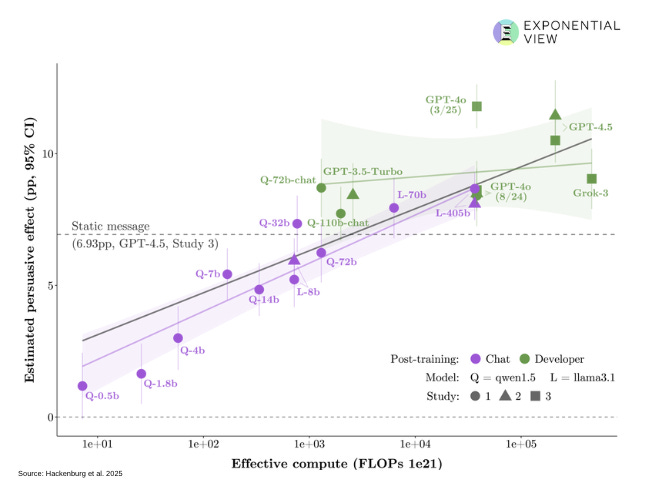🔮 Sunday edition #537: The AI distortion economy. Human skills in decline. AI companions. Antibiotics from AI. China’s quantum leap++
“The level of deep insight into technological trends and forward-looking info you share is unmatched. No one is doing it like you.” – Susan, a paying member
Hi all,
Welcome to our Sunday edition, where we explore the latest developments, ideas, and questions shaping the exponential economy.
Enjoy the weekend reading!
Azeem
A firehose of distortion
Four of the top ten YouTube channels in May featured AI in every video. This isn’t inherently bad. But distortion becomes a problem when it’s so pervasive and cheap that it erodes trust in a society where trust is already scarce.
The AI Security Institute, with Oxford University and MIT, found that top AI chatbots can sway political opinions in under 10 minutes, and 36-42% of those shifts persisted a month later. AI is probably being used to shape opinions under the radar.

A new paper further illustrates the systemic impacts of this. A randomized field experiment with Süddeutsche Zeitung (SZ), one of Germany’s largest and most influential daily newspapers, found that when readers learned how hard it was to distinguish AI-generated images from real ones, their trust in news content dropped – even for SZ. Yet those same readers visited SZ more in the days after (up roughly 2.5%) and were more likely to keep their subscriptions five months later!
Trust in content isn’t the same as trust in a source’s ability to navigate misinformation. At the system level, this could change the structure of the media landscape. Baseline trust sinks, but credibility becomes the scarce asset. A few outlets may consolidate audience loyalty, while the rest are lost in noise.
This is fundamentally different from the “firehose of falsehood” strategy. The Russian propaganda machine used it to overwhelm audiences and erode their ability to distinguish truth from falsehood. Steve Bannon adapted and amplified this approach, “as flooding the zone with shit” in the US, to keep the media reactive and off-balance. His goal was to bury audiences in chaos so it becomes easier for a particular faction to control the narrative. Today’s AI-driven distortion could breed chaos, but it may also raise the competitive value of any source that can convincingly cut through it.
See also, my conversation about the future of media and AI with the CEO of The Atlantic Nicholas Thompson.
No macro, a lot of micro.
Unemployment is increasing, but it’s not because of artificial intelligence. If you’re in an AI-exposed occupation, your unemployment rate is dramatically lower than that of workers not exposed. This supports an idea from economist David Autor that I’ve long promoted: AI is likely having a bigger effect on tasks than on employment.
If we take this view, organizations should make it a priority to use AI to boost cognitive abilities, while also protecting what makes us uniquely human.
In our reflection on GPT-5, we wrote:
Some of GPT‑5’s biggest gains are invisible. When it anticipates needs and makes decisions for you, you do not feel the friction it removes; you just experience the smoother path. But that invisibility makes it risky: the more the model guides you, the more your own curiosity and agency can atrophy.
A new study out this week makes that risk tangible.
